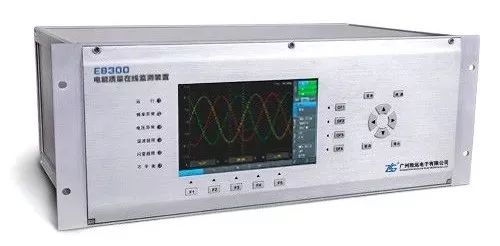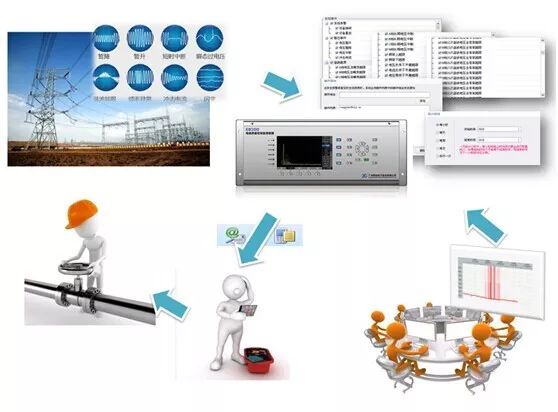The quality of power quality has a serious impact on the military industry, precision instrument processing industry, aerospace, railway transportation, and communications industries. Failure to timely detect abnormal power events in the power grid and effectively respond to them will result in serious safety incidents. What about the grid quality problem and how can it be detected in real time?
Why use a power quality analyzer?
Various kinds of power events in the power grid often indicate some abnormalities in the quality of power grids. Finding these abnormalities in a timely manner and taking countermeasures will greatly help ensure the quality of the power grid and reduce the economic losses and accidents caused by the anomalies. Conversely, if it fails to timely detect abnormal power events in the power grid in a timely manner, serious safety incidents will result.
The quality of power quality is particularly significant for the military industry, precision instrument processing industry, aerospace, railway transportation, and communications industries.

Traditional mass analysis instrument and new on-line power quality detection device
Traditional power event analysis mainly has the following features:
It is usually done with handheld or portable instruments;
When the power grid data needs to be analyzed, the operation and maintenance personnel first carry the power detector to the grid site wiring, collect the data and then export it for analysis.
Due to the need for on-site operation, on-site collection, and export analysis, its safety (danger of electric shock), convenience (on-site waiting for data collection), and timeliness (analysis of results lagging behind) all have great deficiencies. There is a significant time lag for finding electrical energy anomalies in the grid. It is often the case that unusual events happen and cause major economic losses before they spend time and money to monitor grid quality problems.
With the development of power electronics technology, the large-scale use of non-linear loads has caused excessive harmonics and unbalanced three-phase phases. At the same time, many power quality problems such as voltage dips and inrush currents caused by impact loads have caused great impact on the power grid. influences. Traditional power monitoring methods can no longer meet the current requirements for safe, real-time, efficient, and rapid monitoring of power grids.
How to quickly discover and notify abnormal events in the power grid has become an urgent need for new online power monitoring devices.
The new on-line power quality monitoring device is connected to the back office management system through Ethernet. Once installed and deployed once, it can achieve long-term stable power quality monitoring. Compared with traditional power data monitoring methods, on-line security monitoring (without on-site power operation), more efficient (in situ computer data acquisition and analysis, high-performance background server for data deep mining) to monitor and analyze the power grid data, can be achieved Automatic real-time data collection, real-time detection and notification of abnormal events, avoid accidents caused by power quality problems, and reduce economic losses.

E8300 online power detection device
Online Power Quality Analyzer E8300 Series Introduction
ZLG Zhiyuan Electronics Online Power Quality Analyzer E8300 series adopts high-speed and high-performance digital signal processor. It integrates harmonic analysis, flicker measurement, power measurement, voltage unbalance measurement, fault recording, and event recording. Record steady-state data and transient data, and dig deeper into the causes of each event. It can quickly collect and accurately analyze various power parameters, and can monitor and evaluate various indicators of power quality.
ZLG Zhiyuan Electronic Online Power Quality Analyzer E8300 series supports over 300 kinds of abnormal events such as device dropping, voltage abrupt change, voltage and current distortion over limit, content rate over limit, frequency up and down limit, etc. Abnormalities that may occur in all grids. The E8300 series on-line power quality analyzer can detect abnormal events in the power grid in real time and dig out the causes of the events. When an alarm event occurs, the customer can be informed in real time via email. Develop a coping strategy for the customer and dispatch field maintenance personnel to provide assistance so as to avoid accidents caused by abnormal grid quality and reduce economic losses.

Power quality related articles:
What is power quality? What are the power quality? Introduction to the concept of power quality
What are the problems with power quality? What is the harm? Three elements of power quality
A Small Computer System Interface (SCSI) connector, also pounced as [scuzzy" connector, is used for physically connecting and transferring data between computers and peripheral devices.
SCSI is the small computer system interface, which is an independent processor standard used for the system level interface between computer and intelligent devices (hard disk, floppy, optical drive, printer, scanner, etc.). It is an intelligent universal interface standard, which has the function of communicating with various types of peripherals. SCSI uses the standard software interface of ASPI (SCSI programming interface) to make the driver communicate with the SCSI adapter installed inside the computer. SCSI interface is widely used in high-speed data transmission technology on minicomputers. SCSI interface has many advantages, such as wide application range, multitask, wide bandwidth, low CPU utilization, and hot plug.
SCSI connectors type and interfaces
Centronics 50-pin connector: The Centronics 50-pin connector was once the most widely used SCSI connector. An external connector only, the Centronics is a SCSI-1 connector that looks the same as the Centronics cable that attaches to a parallel port printer. The Centronics 50-pin cable comes in male and female styles, and gender changers and cable converters are commonly available. Although used on older SCSI devices and external drive enclosures, this interface is no longer heavily used, due to its slow speed and short cable lengths.
High-density 50-pin connector: The high-density 50-pin connector is used on scanners and Jaz drives. It is one of the more common SCSI connectors and is usually used to connect SCSI-2 devices. Both ends of the cable are usually 50-pin male, while the sockets on the host adapter and external devices are 50-pin female.
DB 25-pin connector: The DB 25-pin or D Sub 25 is by far the most widely used connector. This connector is used for parallel and serial printers in addition to the many other devices available. Both ends of the cable are usually 25-pin male, while the sockets on the host adapter and external devices are 25-pin female. This cable is almost always an external connector.
Note: DB-25 SCSI CABLES are not compatible with and should not be used as serial or printer cables; serial cables and printer cables should not be used or attached to DB-25 SCSI adapters. You can short out the SCSI host adapter or the motherboard by using the wrong cable. Marking cables is the best way to avoid this.
IDC50 connector: The IDC50 is the most common internal SCSI connector. It is very similar to the standard IDE internal ribbon cable. The IDC50 SCSI cable is considerably wider then an IDE ribbon cable; in fact, it is usually the widest standard internal cable in use. This is a standard SCSI-2 10MBps internal SCSI cable. Many low-end cables have only two or three connectors, allowing for one or two devices to be attached to the cable. Seven-device cables are available, though they are often expensive and require a large case, as the cables may be four or five feet long.
High-density 68-pin connector: The high-density 68-pin connector is the SCSI connector of choice for SCSI-3 host adapters and peripherals. There is an internal ribbon cable version that looks very similar to the IDC50 connector. Many low-end cables have only two or three connectors, allowing for one or two devices to be attached to the cable. Seven-device cables are available, though they are often very expensive and require a large case, as the cables may be three or more feet long. Both ends of the external cable are usually 68-pin male, while the sockets on the host adapter and external devices are 68-pin female.
SCA 80-pin Micro-Centronics connector: SCA stands for Single Connector Attachment, a type of disk drive connector that includes connection pins for the power cables as well as the data wires. A SCA connector uses an 80-pin plug and socket to connect peripherals. This connector combines power, data channel, and ID configuration for fast installation and removal. SCA connectors are typically found only on high-end SCSI hard disks. The SCA interface was designed to provide a standard connection for systems using drives that can be hot-swapped. SCA makes swapping SCSI hard drives much easier than with traditional SCSI cables, plugs, and sockets. An adapter enables SCA drives to fit into standard SCSI enclosures.
SCSI SFF 8482: Also called "4x internal" by some vendors. This is a connector with the same form factor as SATA with the addition of a "bump" to key it specifically for SAS. (SATA drives can be plugged into SAS controllers, but SAS drives will not function with a SATA controller; hence, the necessity for the key bump on the connector.) As the name says, it's meant to be used internally, i.e., inside the computer case.
SCSI SFF 8484: Also called "32-pin" or "MultiLane". This is a high density connector usually intended to plug into the motherboard, controller, or backplane itself. Cables with this connector on one end usually have four individual SFF 8482 connectors on the other.
Serial Attached SCSI SFF 8470: Also called "4x external" by some vendors. This is simply a version of the SFF 8484 that's meant to be used with external (i.e., not located within the case) drives.
Scsi Connector,Half Pitch Scsi Connectors,Scsi Lead Half Pitch Male,SCSI (SAS) Connectors,Female Scsi Connector,SCSI Connectors I/O Connectors,Manufacturers and Suppliers in China
ShenZhen Antenk Electronics Co,Ltd , http://www.coincellholder.com
